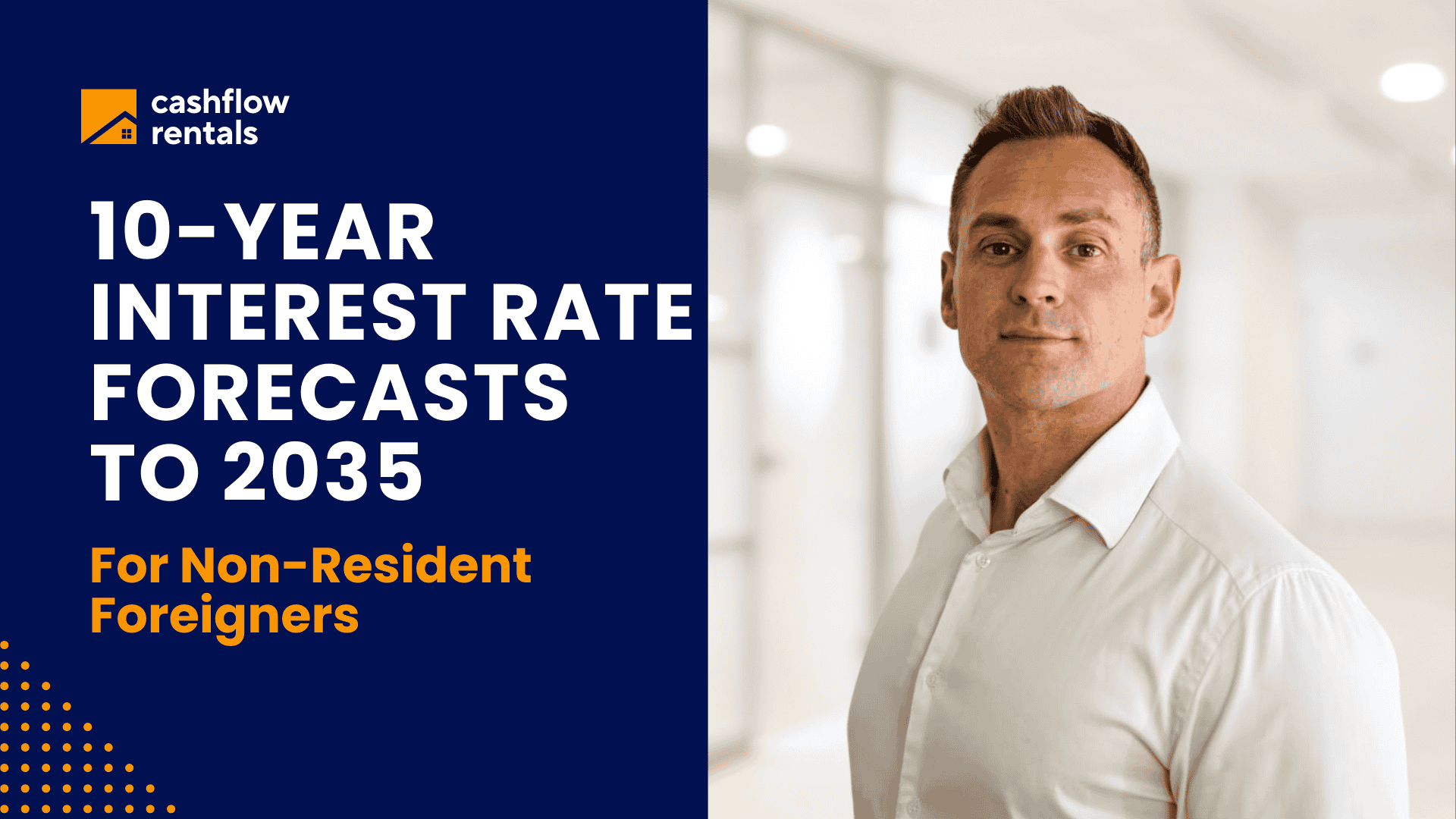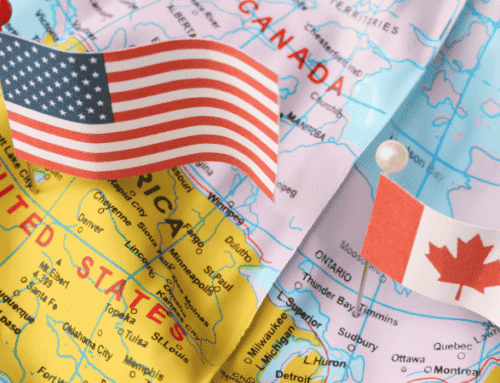US Interest Rate Forecasts for the Next 10 Years to 2035
FREE DOWNLOAD: 10 Costly Mistakes Foreigners Make Buying U.S. Real Estate
What Will Happen to Interest Rates Over the Next 10 Years? Here’s What to Expect
If you’re anything like me, you’ve probably caught yourself wondering where interest rates are headed, and what that means for your finances.
Whether you’re planning a home purchase, managing debt, or trying to optimize your investments, the direction of interest rates over the next decade is more than just a curiosity. It could shape your entire financial strategy.
As someone who has a vested interest in a number of USA property investments, interest rates are always somewhere in my mind.
Looking ahead from 2025 to 2035, most signs point toward a slow and steady retreat from today’s relatively high rates, eventually settling into a moderate, more “normal” range. Think somewhere between 2.5% and 3.5% for the Federal Funds Rate, according to many forecasts. Of course, nothing is set in stone. Economic twists and turns are all but guaranteed, but we can make some informed assumptions based on where things stand now.
Related: Dave Ramseys Predictions for US Mortgage Rates in 2025
Where We Are Right Now (May 2025)
To figure out where we’re going, it helps to take stock of where we are.
As of May 2025, the Federal Reserve has its target interest rate set between 4.25% and 4.50%, with the effective federal funds rate (what banks actually charge each other) sitting around 4.33%.
These rates are lower than the 5.33% peak we saw in August 2023, but still elevated by historical standards. The Fed has paused rate cuts since December 2024, signalling caution as inflation continues to cool and the labor market stays relatively solid.
For context:
30-year fixed mortgage rates are averaging around 6.96%, a key concern for homebuyers.
10-year Treasury yields, which influence a variety of borrowing costs, are about 4.63% in May 2025.
So while we’ve come off the highs, we’re not in the low-rate territory many grew accustomed to in the 2010s.
Related: Unlocking Value in the US Housing Market
What Experts Expect in the Short Term (2025–2027)
Looking at the next few years, most major institutions expect a gradual easing of interest rates rather than any sharp drops.
Here’s a look at some of the current projections:
| Year | Federal Funds Rate (Median Projection) |
|---|---|
| 2025 | 3.9% |
| 2026 | 3.4% |
| 2027 | 3.1% |
Source: Federal Reserve, March 2025 Summary of Economic Projections
The Fed’s thinking? A slow and measured path downward as inflation cools and the economy steadies. Other forecasters echo that:
CBO expects the rate to reach 3.7% by the end of 2025 and 3.4% in 2026.
Goldman Sachs foresees a series of modest cuts bringing the rate closer to 3.5% by year-end.
Morningstar is even more optimistic, suggesting a drop to 2.5% by mid-2027 if inflation trends lower.
This isn’t a race to zero, it’s a controlled descent aimed at avoiding both runaway inflation and a hard economic landing. If that happens, it could make borrowing cheaper without compromising stability.
Related: The Market Advantage for Foreign Property Investors in the USA
What Might Happen After That? (2028–2035)
Now comes the trickier part: the long-range forecast. Looking 5-10 years out always involves a fair bit of uncertainty. Still, institutions like the Fed, CBO, and Morningstar offer some rough estimates of what a “neutral” interest rate might look like when the economy is balanced and inflation is stable.
Here’s the general consensus:
Federal Reserve estimates a long-run neutral rate of 3.0%.
CBO leans a bit higher, forecasting around 3.4%.
Morningstar, on the lower end, sees it settling in the 2.25%–2.50% range.
So if things go more or less according to plan, we may be living in a world of moderate rates—not the ultra-low levels of the early 2020s, but nowhere near the 5%+ range we’ve seen recently.
Of course, unexpected events (geopolitical conflict, fiscal policy shifts, trade wars, you name it) could cause big swings. A sudden recession, for instance, could prompt the Fed to cut rates quickly. A surge in inflation? Back up they go.
Related: Hidden Costs of Buying Cheap Investment Property in the USA
Key Rates to Watch
While the Fed Funds Rate gets most of the headlines, other rates matter too:
🔹 10-Year Treasury Yield
Currently around 4.63%
Expected to drift lower; Bankrate’s survey suggests it could land near 3.55% by the end of 2025
Historically runs about 1 – 2% higher than the Federal Funds Rate
🔹 Mortgage Rates
The average 30-year fixed mortgage rate is 6.96% today
Fannie Mae predicts a drop to around 6.3% by late 2025 and 6.2% in 2026
A small decline here could significantly improve affordability for homebuyers
For us foreigners investing in the US property market, we rely on DSCR loans to purchase our investment properties. Currently we’re getting interest rates of between 6.75% and 8% for our international buyers.
Related: Local Market Expertise is Essential for Overseas Property Investors
What Influences Interest Rates?
Here are the forces that really move the needle:
1. Inflation: The Fed’s primary focus. If inflation stays sticky above the 2% target, rates will remain elevated. If it falls, there’s more room to cut.
2. Economic Growth: Steady but modest growth is expected, around 1.8% annually through 2035, per the CBO. Stronger-than-expected growth could put upward pressure on rates.
3. Government Spending & Debt: The national debt is projected to keep growing, and interest on that debt will soon outpace military spending. More borrowing = potential rate pressure.
4. Global Developments: Trade policies, supply chain disruptions, or international recessions all affect the U.S. rate landscape.
5. Demographics & Productivity: Aging populations and slower workforce growth can drag on long-term economic output, keeping rates subdued.
6. Wildcards: Breakthrough tech, energy shocks, or geopolitical instability could all throw off predictions. A leap in AI productivity? Rates may stay lower. A global conflict? They might spike.
Related: Successful Foreign Investors Use Local Market Data to Identify Opportunities
What This Means for Everyday People
📌 Borrowers: If rates ease as expected, mortgages, car loans, and credit cards should all become more affordable. That said, timing matters, waiting a few months might mean a better deal, but not a dramatic shift.
📌 Savers: Interest on savings could dip as rates fall. Locking in current CD rates might be a smart move if you want to preserve yield.
📌 Investors: Falling rates typically boost bond prices and can provide tailwinds for stocks, especially in sectors sensitive to borrowing costs. But inflation and geopolitical risk remain wildcards. In my opinion, investors will do best by focussing on the best US property markets and specific rather then interest rates alone.
📌 Businesses: Easier financing could spur growth and investment, but companies must stay nimble amid shifting global dynamics.
📌 Policymakers: The Fed will need to juggle rate cuts with inflation control, while the government faces tough questions about long-term debt and fiscal sustainability.
Related: Why Foreigners Are Buying Investment Properties in the Northeast Midwest and South
Final Takeaway: Use Projections, But Plan for Flexibility
The next 10 years of interest rates will likely involve a slow descent from today’s highs toward a more balanced middle ground. But no one can promise a smooth ride. The economy is full of surprises, and the best-laid forecasts are always subject to revision.
So here’s my advice: use these projections to guide your financial decisions, but don’t count on them as certainties. Stay nimble, stay informed, and be ready to adjust your strategy if the road ahead takes an unexpected turn.
FREE DOWNLOAD: 10 Costly Mistakes Foreigners Make Buying U.S. Real Estate







![USA Property Investment for Foreign Buyers [2025 Guide]](https://cashflowrentals.net/wp-content/uploads/2025/07/USA-Property-Investment-for-Foreigners-Expert-2025-Guide-500x383.png)



